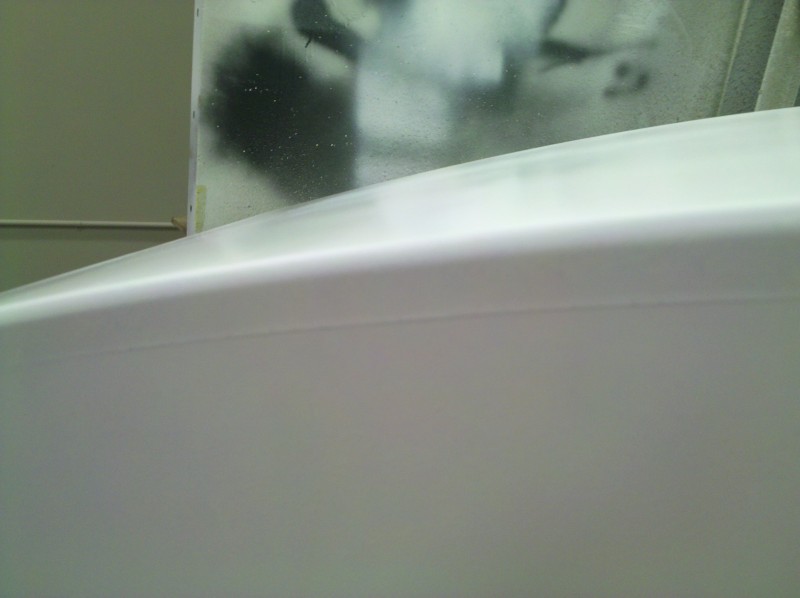Waterborne Finish Raising MDF Glue Line
Glued joints in MDF sometimes telegraph through waterborne finishes because of the effects of moisture. Here's advice on prevention and cure. December 31, 2012
Question
I'm using ML Campbell's waterborne Agualente. I glued the top of my radius cabinet with MDF and Titebond II. The edges were flush trimmed and sanded to 220. After I put two coats of primer on (sanding with 320 in between), the edges of the MDF were looking good, but I swear the glue line raised. I actually scraped the glue line (which was now proud of the primer coat) with a razor, sanded and added a third coat. I sprayed a little heavy, which is where the picture is at now. Has anyone ever seen a glue line raise from a waterborne product before? If so, would you seal the MDF edge before the opaque primer is sprayed?

Click here for higher quality, full size image
Forum Responses
(Finishing Forum)
From contributor D:
I see that all the time. You have to let things dry longer between coats, or at least your primer coat. MDF is the worst for this, which is why we use poplar when doing what you are doing. You can't lay on several waterborne coats in a short time like solvent.
From contributor I:
Contributor D is correct. I have also seen this many times. Make sure the glue is good and dry. I also find that using 320 grit on an orbital on the edges help prevent this. Using a course grit paper only raises the fiber. Use 320 and you can thank me later.
From the original questioner:
Thanks! I assumed since it was powdering up as I sanded it, it would be ready for recoat. You're saying you have to double the amount of time for solvent, or how do you gauge that? Two coats a day, three coats under a fan?
The 320 orbital is in reference to before I spray, correct?
I was a little surprised the glue did that. I had clamped the curved top up Thursday, so that's 4 days dried. It worked, and sanded quite well. In my mind it was more like the primer somehow pulled up the glue. I was able to cut the glue out, which was standing proud of the primer!
From contributor D:
Try to use
Titebond 3 as your glue for this as it may be a bit more waterproof. The trouble is when the waterborne hits the MDF and glue line and not how dry the glue is. I meant to say let the first coat of primer dry well, like 8 hours, if you can afford the time. Or you can use a heat gun a bit. Sand to 320 and then repeat. There is always that micro line junction of veneer and MDF which is troublesome with water.
From contributor A:
Contributor D, hate to argue, but
Titebond 3 produces the worst gluelines.
Titebond 2 likewise.
Titebond 1 rarely is troublesome. The softer the glue, the more apparent.
Titebond 3 does not dry hard. The old fashioned white glues were the worst. They also clogged sandpaper like the big times. In my experience, the glue produces the line, not the finish. Rarely when it does happen, it is very hard to cover it with any finish.
From contributor D:
Thanks. I should test those 3 glues separately. I have them all in my shop.
From contributor R:
You mentioned trimming, then sanding the MDF down to 220 grit. The glue is harder than the MDF, meaning you most likely removed more MDF than glue, leaving a ridge of glue.
From contributor B:
Actually, I never sanded the primer down to the bare MDF edge with my orbital. Sorry if I was vague. The little details always matter in finishing it seems.
The finish ended up being okay. I ended up with another coat of primer that I could have done without. More drying time, better orbital sanding got me there. Much thanks for the advice.
From contributor C:
Try a
polyurethane glue next time.
